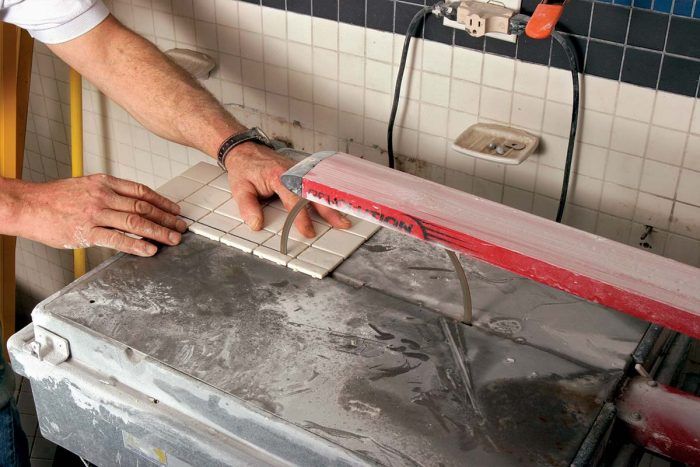Buying or Renting Tile Saws
A veteran tile-setter explains how to choose the best saw for the job.

Synopsis: For a great deal of bathroom work (as well as certain jobs elsewhere in a house), tile is a key building component, and that frequently means needing to cut tile to fit in specific spots. A tile saw is a necessity for these kinds of projects. Veteran tile-setter Tom Meehan has had plenty of opportunity to work with tile saws, and he shares his insights in this article. Meehan covers topics including score-and-snap tile cutters, diamond blades, kitchen backsplashes, holes for electrical outlets, tile wainscot, curves, indoor vs. outdoor use of tile saws, and techniques for cutting small tiles. This article includes a sidebar on Meehan’s two favorite tile-saw models.
When I started my tile company in the 1970s, I spent $800 on a heavy-duty tub-style tile saw. It wasn’t flashy and didn’t have any bells and whistles, but it was the best tool at the time.
Thirty years later, prices haven’t risen all that much, but the options are incredible. There are saws that run smoothly enough to make clean cuts in glass tile and others that are powerful enough to bulldoze through miles of granite without popping a circuit breaker. Some tile saws excel at accurate bevel cuts, and others are indispensable for making plunge cuts or creating curves.
The fact is that there are a number of well-made, modern tile saws that allow inexperienced tile setters to complete projects that took old-timers years to perfect. But the trouble with any market that becomes flooded with options is more difficulty in making the best choice. You can ask the clerk behind the rental desk at the local home center which saw is right for your project, but chances are that the clerk’s insights reach only as far as the saw or saws in stock.
I have been in the tile business for more than half my life, have always had three or four installers on my crew, have owned more than 25 saws, and have tried countless others. The following questions and answers cover what I think are the most important features and differences in modern tile saws. Of course, no single saw does everything perfectly, but knowing the saws’ strengths and weaknesses makes it easier when choosing the right one for your next project.
Q: Do I need a tile saw at all, or can I do the job with a score-and snap tile cutter?
I use a snap cutter as often as possible. They are inexpensive, quick, clean, quiet, and dry. My favorite ones are made by Superior Tile Cutters. The trouble is that this type of tool doesn’t work with all varieties of tile—it is best suited for ceramics—and it can make only continuous straight cuts. You’ll need a wet saw any time you have to cut around electrical outlets, vent registers, and plumbing penetrations.
Q: I want to tile the floor in my master bathroom with granite tiles set in a diagonal pattern. Can the necessary cuts be made on any wet saw?
Granite is one of the hardest tiles, and a diagonal pattern means that every tile on the perimeter of the room needs to be cut in half. Most wet saws can muscle through hard tile, but models with small motors will bog down, have you running back and forth to reset popped circuit breakers, and burn out prematurely. Look for a saw that has a motor with at least 1½ hp (continuous, not peak). My choice for a full day of hard cutting of big tiles is the Husqvarna TS 250.
Magazine extra: Read Tom Meehan’s first impressions of Ridgid’s newest tile saw. Also, you can learn more about Ditra, the tile underlayment Meehan uses in the project featured in his article by watching our video demo.
For more photos and details, click the View PDF button below:





